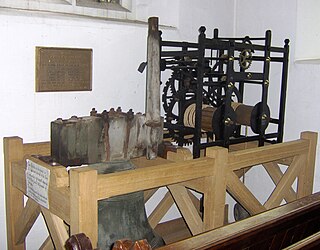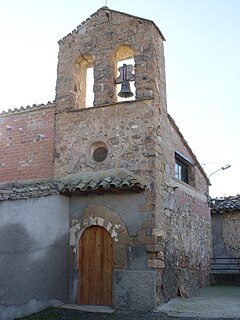
Change ringing is the art of ringing a set of tuned bells in a controlled manner to produce variations in their striking sequences. This may be by method ringing in which the ringers commit to memory the rules for generating each change, or by call changes, where the ringers are instructed how to generate each new change by calls from a conductor. This creates a form of bell music which cannot be discerned as a conventional melody.

Tubular bells (also known as chimes) are musical instruments in the percussion family. Their sound resembles that of church bells, carillon, or a bell tower; the original tubular bells were made to duplicate the sound of church bells within an ensemble. Each bell is a metal tube, 30–38 mm (1 1⁄4–1 1⁄2 in) in diameter, tuned by altering its length. Its standard range is C4–F5, though many professional instruments reach G5. Tubular bells are often replaced by studio chimes, which are a smaller and usually less expensive instrument. Studio chimes are similar in appearance to tubular bells, but each bell has a smaller diameter than the corresponding bell on tubular bells.

The Whitechapel Bell Foundry was a business in the London Borough of Tower Hamlets. At the time of the closure of its Whitechapel premises, it was the oldest manufacturing company in Great Britain. The bell foundry primarily made church bells and their fittings and accessories, although it also provided single tolling bells, carillon bells and handbells. The foundry was notable for being the original manufacturer of the Liberty Bell, a famous non-religious symbol of United States independence, and for re-casting Big Ben, which rings from the north clock tower at the Houses of Parliament in London.

St Mary-le-Bow is a historic church rebuilt after the Great Fire of 1666 by Sir Christopher Wren in the City of London on the main east–west thoroughfare, Cheapside. According to tradition a true Cockney must be born within earshot of the sound of Bow Bells.

A bell tower is a tower that contains one or more bells, or that is designed to hold bells even if it has none. Such a tower commonly serves as part of a church, and will contain church bells, but there are also many secular bell towers, often part of a municipal building, an educational establishment, or a tower built specifically to house a carillon. Church bell towers often incorporate clocks, and secular towers usually do, as a public service.

A bell is a directly struck idiophone percussion instrument. Most bells have the shape of a hollow cup that when struck vibrates in a single strong strike tone, with its sides forming an efficient resonator. The strike may be made by an internal "clapper" or "uvula", an external hammer, or—in small bells—by a small loose sphere enclosed within the body of the bell.

The Ivan the Great Bell Tower is a church tower inside the Saint Basil's Cathedral complex. With a total height of 81 metres (266 ft), it is the tallest tower and structure of Kremlin. It was built in 1508 on Cathedral Square for the 3 Russian Orthodox cathedrals, namely the Assumption, the Archangel and the Annunciation, which do not have their own belfries. It serves as a part of Moscow Kremlin Museums.

John Taylor & Co, commonly known as Taylor's Bell Foundry, Taylor's of Loughborough, or simply Taylor's, is the world's largest working bell foundry. It is in Loughborough, in the Charnwood borough of Leicestershire, England. The business originated in the 14th century and became Taylor's after the Taylor family took over in 1784.

A church bell in the Christian tradition is a bell which is rung in a church for a variety of ceremonial purposes, and can be heard outside the building. Traditionally they were used to call worshippers to the church for a communal service, and to announce times of daily prayer, called the canonical hours. They are also rung on special occasions such as a wedding, or a funeral service. In some religious traditions they are used within the liturgy of the church service to signify to people that a particular part of the service has been reached. The ringing of church bells, in the Christian tradition, was also believed to drive out demons.

The Angelus is a Catholic devotion commemorating the Incarnation. As with many Catholic prayers, the name Angelus is derived from its incipit—the first few words of the text: Angelus Domini nuntiavit Mariæ. The devotion is practised by reciting as versicle and response three Biblical verses narrating the mystery, alternating with the prayer "Hail Mary". The Angelus exemplifies a species of prayers called the "prayer of the devotee".

The Armenian Church, Chennai, constructed in 1712 and reconstructed in 1772, is one of the oldest churches of the Indian subcontinent. It is famous for its belfry of six. The Church, also called the Armenian Church of Virgin Mary, is located on the Armenian Street, Parrys, George Town, Chennai, South India.
A bell-cot, bell-cote or bellcote is a small framework and shelter for one or more bells. Bellcotes are most common in church architecture but are also seen on institutions such as schools. The bellcote may be carried on brackets projecting from a wall or built on the roof of chapels or churches that have no towers. The bellcote often holds the Sanctus bell that is rung at the consecration of the eucharist.

Russian Orthodox bell ringing has a history starting from the baptism of Rus in 988 and plays an important role in the traditions of the Russian Orthodox Church.

A "Ring of bells" is the name bell ringers give to a set of bells hung for English full circle ringing. The term "peal of bells" is often erroneously used, as a peal refers to a change ringing performance of more than about 5,000 changes.

Dove's Guide for Church Bell Ringers is the standard reference to the rings of bells hung for English-style full-circle bell ringing. The vast majority of these "towers" are in England and Wales but the guide includes towers from the rest of the British Isles as well as a few from around the world. The latest edition is Dove’s Guide for Church Bell Ringers to the Rings of Bells of the World.

St Edburgha's Church is a parish church in the Yardley area of Birmingham, England. It is a Grade I listed building and a part of the Old Yardley conservation area.

The Bilbie family were bell founders and clockmakers based initially in Chew Stoke, Somerset and later at Cullompton, Devon in south-west England from the late 17th century to the early 19th century.
Rudhall of Gloucester was a family business of bell founders in the city of Gloucester, England, who between 1684 and 1835 produced over 5,000 bells.

The bell gable is an architectural element crowning at the upper end of the wall of church buildings, usually in lieu of a church tower. It consists of a gable end in stone, with small hollow semi-circular arches where the church bells are placed. It is a characteristic example of the simplicity of Romanesque architecture.

















